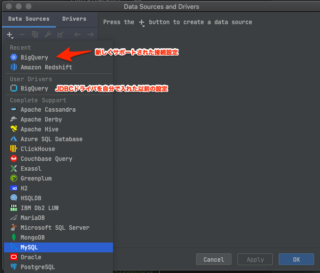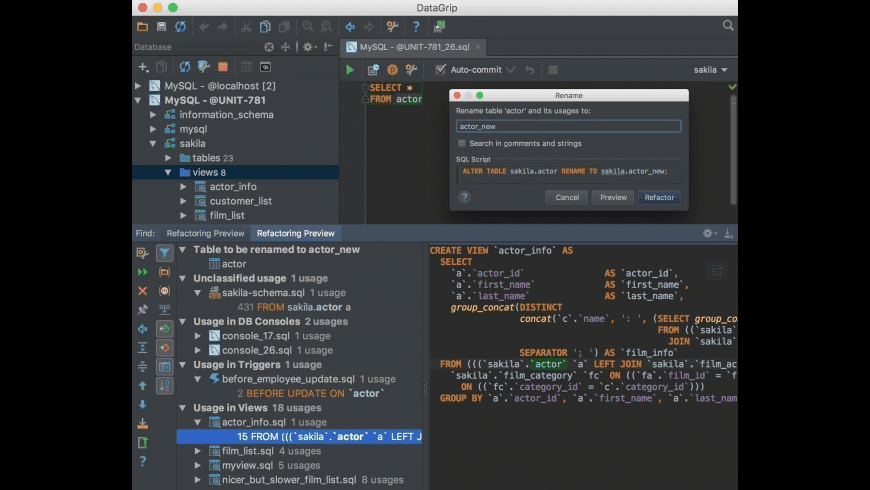

- #Datagrip bigquery how to#
- #Datagrip bigquery for mac#
- #Datagrip bigquery pro#
- #Datagrip bigquery mac#
SQL Squirrel is another open-source option:ĭataGrip, while not free, might be compelling given the UI and feature set:


Definitive Guide For Connecting Oracle SQL Developer to Amazon Redshift.If you are really interested in pushing boundaries and wedded to everything Oracle, did you know you can use their SQL Tool to connect with Redshift?
#Datagrip bigquery how to#
How To Guide Connecting Popular SQL Workbench to Redshift.This guide details how to get set up quickly: If you want to go old school SQL Workbench is a trusted go-to tool.
#Datagrip bigquery pro#
It is unfortunate, for novice and pro users, TeamSQL certainly offered a number of features that increase productivity.
#Datagrip bigquery mac#
One of the best GUI tools available for the Mac and Windows was TeamSQL which is no longer offered. There are a number of options in the market.
#Datagrip bigquery for mac#
With the Use original case checkbox enabled, when you reformat code in View_1.sql, the original case from the package declaration in Pack_1.sql is applied.What is the best SQL client for Mac and Windows when working with Redshift, Athena, BigQuery, PostgreSQL and MySQL? On the following image, you can see Pack_1.sql and View_1.sql. Alternatively, in the attached directory, select all the files that are in the DDL data source, right-click the selection and click Reformat Code. Ĭlick Code | Reformat Code or press Ctrl+Alt+L to apply the declaration case in any file of the DDL data source. Select the dialect in which you want to apply the declaration case settings.Ĭlick the Case tab and select the Use original case checkbox. In Pack_2.sql, the case from the package declaration was applied throughout the whole file.Īpply the declaration case in multiple filesĬreate a DDL data source from the files for which you want to apply the declaration case. Pack_2.sql was reformatted with the Use original case checkbox enabled. On the following image, you can see Pack_1.sql and Pack_2.sql with identical code. Select the dialect in which you want to apply the original case from the declaration.Ĭlick the Case tab and select the Use original case checkbox.Ĭlick Code | Reformat Code or press Ctrl+Alt+L. Open settings by pressing Ctrl+Alt+S and navigate to Editor | SQL. To apply the case in multiple files, create a DDL data source from these files. To apply this case throughout the file, DataGrip must find the declaration of these variables, procedures, and functions (for example, in the CREATE PACKAGE statement). For example, if you defined the get_Amount function in the CREATE PACKAGE statement, you want the same case throughout your code, not GET_AMOUNT or get_amount. SQL.Īpply the original case from the declarationĭataGrip can format names of variables, procedures, and functions as you defined them initially. For more information about code style settings, see Code Style. Open settings by pressing Ctrl+Alt+S and navigate to Code Style | SQL | SQL:2016, Generic.Ĭlear the Inherit general SQL style checkbox.Īpply code style settings. Or, import settings from the dialect that you configured. You can select preconfigured styles like Modern, Joe Celko, Allman (DDL only)), Whitesmiths (DDL only)), Egypt, Old Idea. In the Files tool window ( View | Tool Windows | Files), right-click a directory and select Reformat Code.Ĭlick the Set from link and select the style that you want to import. You can format files from the context menu without opening them. Alternatively, press Ctrl+Alt+L.Īpply a code style to a file from the context menu Right-click any area in the editor and select Reformat. In the Code style drop-down menu, select a style that you want to apply. Right-click a data source and select Properties. Select all the necessary code style settings, and click Apply.Īfter you created a style for a dialect, you can apply this style to the data source that uses this dialect. Type a name for a new style, and press Enter. Create a code style for a dialectĬlick the Show Scheme Actions icon ( ), and select Duplicate. When you apply the rule, DataGrip updates the SQL code and highlights all modified parts in the Preview pane. Select all the necessary code style settings on the available tabs. Open settings by pressing Ctrl+Alt+S and navigate to Editor | Code Style | SQL.Įxpand the SQL node and select a dialect. Change code style settingsĬustomize formatting rules for the SQL code: alignment, wrapping, and indentation.
To see the description of SQL style options, see Code Style. This will refer to the table it's getting the data from for current query, sometimes it says instead of the table nameYou can apply and customize the SQL code style that satisfies code guidelines of your company.


 0 kommentar(er)
0 kommentar(er)
